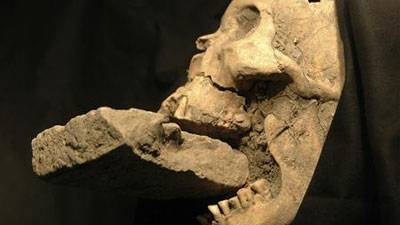Vampire Skeletons Found in Bulgaria
Zombies and ghoulish attacks have been in the mainstream recently breathing new life into the stuff of myth and darkness. You can add to that pop culture phenomenon with the newest archaeological find in Bulgaria - vampires.Archaeologists there have exhumed two medieval skeletons in Sozopol, on the Black Sea.
The corpses have been pierced through the chest with iron rods, presumably by unnerved townsfolk in hopes of keeping the bodies from becoming undead and rising from the graves.
Several of these Balkan dig sites , which number over 100, have demonstrated the local customs and lore of the times, and revealed how serious was the perceived threat of the undead. Those historic beliefs are now the stuff of modern legend and religion.
The Daily Mail reports:
The two skeletons, believed to be around 800 years old, were discovered during an archaeological dig near a monastery in the Bulgarian Black Sea town of Sozopol.
Bulgaria’s national history museum chief Bozhidar Dimitrov said: ’These two skeletons stabbed with rods illustrate a practice which was common in some Bulgarian villages up until the first decade of the 20th century.’
Dimitrov explains, "These people were believed to be evil while they were alive, and it was believed that they would become vampires once they are dead, continuing to torment people." He further notes that ’vampires’ were often aristocrats and clerics.
These new finds echo the mystery of another discovery in Venice, Italy, where researchers found the remains of a ’female vampire’, identified by the clay brick that had been jammed into her mouth after death.
The brick is thought to have been used to prevent the woman feeding on victims of a plague which swept through the city in the 16th Century.
Experts said the discovery supported the medieval belief that vampires were behind the spread of plagues like the Black Death.
The skeleton was unearthed in a mass grave from the Venetian plague of 1576 - in which the artist Titian died - on the small island of Lazzaretto Nuovo in the Venice lagoon.
Situated around two miles north east of Venice, the grave was used as a sanatorium for plague sufferers.
Matteo Borrini, of the University of Florence, said: "This is the first time that archaeology has succeeded in reconstructing the ritual of exorcism of a vampire. This helps... authenticate how the myth of vampires was born."
Source
Legends and fears of blood-sucking, undead beings date back thousands of years, but those tales have only evolved and reshaped in the telling, and have not diminished in modern times.
By Elizabeth Leafloor, RedIceCreations.com
Source Articles:
BBC
DailyMail
SkyNews
























